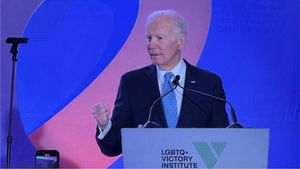
Treatment GuideJust DiagnosedSex & DatingAfrican AmericanStigmaAsk the HIV DocPrEP En EspañolNewsVoicesPrint IssueVideoOut 100
CONTACTCAREER OPPORTUNITIESADVERTISE WITH USPRIVACY POLICYPRIVACY PREFERENCESTERMS OF USELEGAL NOTICE
© 2025 Pride Publishing Inc.
All Rights reserved
All Rights reserved
By continuing to use our site, you agree to our Privacy Policy and Terms of Use.
Research published in Clinical Infectious Diseases shows a new strategy for fighting HIV, called a kick and kill strategy. The kick and kill strategy would aim to cure HIV by activating the body’s own immune system to fight the virus. In a kick and kill strategy, a vaccine is used to stimulate the immune system, then a dormant form of the virus in white blood cells is re-awakened with a chemical “kick” that boosts the immune system to target and kill HIV.
In theory, this strategy sounds great, but in practice, researchers are skeptical. Previous researchers were unsure whether the body could handle a reintroduction to a full-blown reactivation of HIV. But this new research — though based on just a single case study — does show some promise.
“Our study shows that the immune system can be as powerful as the most potent combination drug cocktails,” explains study co-author and Wellcome Trust fellow Dr. Ravi Gupta, University College of London Infection and Immunity. “We’re still a long way from being able to cure HIV patients, as we still need to develop and test effective vaccines, but this study takes us one step closer by showing us what type of immune responses an effective vaccine should induce.”
The study led by University College London Hospitals NHS Foundation Trust, the University of Oxford and the University of North Carolina at Chapel Hill looked at a 59-year-old HIV patient known as an “elite controller” or, a patient whose immune system is highly active against HIV. Elite controllers make up about 0.3 percent of HIV positive people, and while they eventually need drug treatments to prevent AIDS, they can go much longer than other patients without intervention.
The patient, who had HIV and myeloma, a cancer of bone marrow, had his bone marrow completely removed and replaced using his own stem cells. This procedure caused a reintroduction of HIV that flooded his system. The level of the virus in his bloodstream went from 50 copies per milliliter to 28,000 copies. Once his immune function returned, there was a drop back to 50 copies within six weeks.
The patient wasn’t given any HIV treatments during this time out of fear of side effects, however it is possible that had he been given treatments, he could have been cured. Researchers are cautious of making such statements though.
“We need to be cautious in interpreting observations from a single subject,” says Dr. Nilu Goonetilleke, who began working on the study at the University of Oxford and is now at the University of North Carolina at Chapel Hill. “However, demonstration even from a single subject, that our immune system can rapidly control HIV-1 tells us a lot about the types of immune responses we should target and augment through vaccination.”
From our Sponsors
Most Popular
“So much life to live”: Eric Nieves on thriving with HIV
September 03 2025 11:37 AM
The Talk: Beyond the exam room
August 13 2025 3:15 PM
Thanks to U=U, HIV-positive people can live long, happy, healthy lives
July 25 2025 2:37 PM
BREAKING: Supreme Court rules to save free access to preventive care, including PrEP
June 27 2025 10:32 AM
Messenger RNA could be the key to an HIV vaccine — but government cuts pose a threat
August 20 2025 8:02 AM
“I felt like a butterfly”: Niko Flowers on reclaiming life with HIV
July 23 2025 12:22 PM
Dancer. Healer. Survivor. DéShaun Armbrister is all of the above
July 02 2025 8:23 PM
The Talk: Starting the conversation
July 25 2025 4:47 PM
The lab coat just got queer
August 21 2025 10:00 AM
Plus: Featured Video
Latest Stories
HIV-positive men stage 'Kiss-In' protest at U.S.-Mexico border
December 01 2025 12:56 PM
What the AIDS crisis stole from Black gay men
December 01 2025 6:00 AM
Amazing People of 2025: Javier Muñoz
October 17 2025 7:35 PM
It’s National PrEP Day! Learn the latest about HIV prevention
October 10 2025 9:00 AM
“I am the steward of my ship”: John Gibson rewrites his HIV narrative
September 16 2025 2:56 PM
The Talk: Owning your voice
August 25 2025 8:16 PM
The Talk: Navigating your treatment
August 01 2025 6:02 PM
How the Black AIDS Institute continues to fill in the gaps
July 25 2025 1:06 PM
1985: the year the AIDS crisis finally broke through the silence
June 26 2025 11:24 AM
VIDEO: A man living with HIV discusses his journey to fatherhood
June 10 2025 4:58 PM
Trump admin guts $258 million in funding for HIV vaccine research
June 03 2025 3:47 PM
Grindr is reminding us why jockstraps are so sexy and iconic
May 02 2025 5:36 PM
HRC holds 'die-in' to protest Trump health care cuts
April 28 2025 2:11 PM
Two right-wing Supreme Court justices signal they may uphold access to PrEP and more
April 21 2025 4:10 PM
500,000 Children at Risk: PEPFAR Funding Crisis
April 08 2025 3:51 PM
Broadway's best raise over $1 million for LGBTQ+ and HIV causes
April 03 2025 7:15 PM
The Talk Season 5 premieres this spring with HIV guidance for the newly diagnosed
March 26 2025 1:00 PM







































































